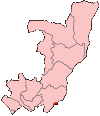Brazzaville
Brazzaville | |
|---|---|
| Image of Kinshasa and Brazzaville, taken by NASA. Image of Kinshasa and Brazzaville, taken by NASA. | |
 Map of the Republic of Congo showing Brazzaville. | |
| Capital district | Brazzaville |
| Government | |
| • Governor | Hugues Ngouélondélé |
| Population (2005) | |
| • Total | 1,174,000 |
Brazzaville is the capital and largest city of the Republic of the Congo and is located on the Congo River. It has a population of 1,174,000 (2005 census). The city was founded in 1880 on the site of a village named Nkuna by an Italian explorer, Pierre Savorgnan de Brazza, after whom the city was named. Over a third of the population of the Republic of Congo lives in the capital, and it is home to 40% of non-agricultural employment. It is also a financial and administrative capital.
Geography

Brazzaville is located at 4°16′S 15°17′E / 4.267°S 15.283°E [1]. In order to distinguish between the two African countries with "Congo" in their names, the Republic of the Congo is sometimes called Congo-Brazzaville, as opposed to Congo-Kinshasa (the Democratic Republic of the Congo, known from 1971 to 1997 as Zaire, the capital of which is Kinshasa). Kinshasa lies on the southern bank of the Congo, across from Brazzaville. This is the only place in the world where two national capital cities are situated on opposite banks of a river, within sight of each other.
While Kinshasa lies to the south, Brazzaville lies to the north of the Congo River. The city is 506 km inland from the Atlantic Ocean and south of the equator. The city is a commune that is separated from the other regions of the republic; it is surrounded by the Pool Region. Around the city is a large savanna. The town is relatively flat, and situated at an altitude of 317 metres.
History
The city was founded on the 10 September, 1880 on the site of a village named Nkuna by an Italian explorer, Pierre Savorgnan de Brazza, after whom the city was named. The local leader, Makoko of the Téké signed an treaty of protection with de Brazza which subjugated his lands to the French Empire. The city was built four years later in order to become a competitor with Léopoldville (now Kinshasa) which was build by the Belgians on the other side of the river.
French control over the area was made official by the Berlin Congress of 1884. The city became the capital first of the French Congo, and then of French Equatorial Africa, a federation of states which encompassed Gabon, the Central African Republic and Chad. In 1924, the Congo-Océan railway was bought into service which linked Brazzaville with the port of Pointe-Noire.
In 1944, Brazzaville hosted a meeting of the Free French forces and representatives of France's African colonies. The resulting Brazzaville Declaration was intended to redefine the relationship between France and its African colonies after World War II.
Until the 1960s, the city was divided into European (the center of the city) and African sections (Poto-Poto, Bacongo, and Makélékélé). In 1980 it became a "commune" separated from the Pool Region and divided into seven "arrondissements": Makélékélé (1), Bacongo (2), Poto-Poto (3), Moungali (4), Ouenzé (5), Talangaï (6) and Mfilou (7).
The city has frequently been a staging ground for regional conflicts, including conflicts between rebel and government forces and between forces of the Republic of Congo, the Democratic Republic of the Congo, and Angola.
Industry
Industries present in Brazzaville include: machine shops, textiles, tanning, and manufacturing. As a key port on the Congo River, the city takes deliveries of raw materials, such as: rubber, wood and agricultural products. From here they are generally sent onward to Pointe-Noire for export.
Buildings and institutions
Notable buildings in the city include St Anne's Basilica, built in 1949 by Roger Erell, and known for its green tiled roof; Erell also designed a house in the city for Charles de Gaulle. Other buildings include the ELF Tower and the Congressional Palace. Other features include the Marien Nguouabi Museum, Brazzaville Zoo and the Poto-Poto Art School.
The World Health Organization Regional Office for Africa is based in Brazzaville on a vast campus at the Cité du Djoué.
Transport
The city is home to Maya-Maya Airport and a railway station on the Congo-Ocean Railway. It is also an important river port, with ferries sailing to Kinshasa and to Bangui via Impfondo. The port for ferries to Kinshasa is known locally as "The Beach". The Congo River Rapids lie on the outskirts of the city, where the Djoué River meets the Congo, rendering river transport to the coast impossible.
Town twinning
References
- Tiepolo, M. (1996) "City Profile: Brazzaville" in Cities v. 13, pp. 117-124
